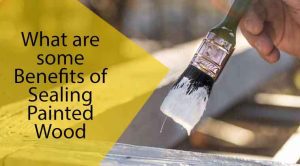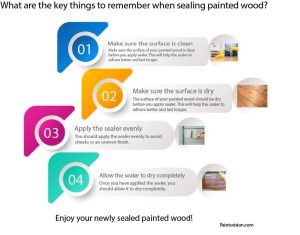Painted wood is a beautiful and durable material that You can use for indoor and outdoor purposes. The key to making sure your painted wood projects last for years is to seal the paint properly. By sealing the paint, you are essentially creating a barrier between the elements and the wood, which will protect it from damage. But how to seal painted wood for outdoor use?
If you plan on using painted wood for an outdoor project, there are a few things you need to do to seal it properly. In this article, we will go over how to seal painted wood for outdoor use so that your projects will look great and last for years to come.
Why is it important to seal painted wood?
Your outdoor furniture is constantly bombarded by the elements — sun, rain, dirt, and more. It takes a beating day in and day out, and unless you take care of it, it will start to show its age.
Unsealed wood will also soak up water like a sponge, cracking, warping, and rotting. Even treated wood can succumb to the elements if not properly sealed. When your furniture is not sealed correctly, it becomes more challenging to clean.
One way to protect your outdoor furniture is by sealing it with a clear coat of sealer. This will create a barrier between the elements and the paint, keeping your furniture looking newer for longer.
What are some benefits of sealing painted wood?
Sealer offers many benefits to painted wood, including:
Ease of cleaning: It will be easier to clean when your furniture is sealed. Wipe it down with a damp cloth or hose it off as needed.
Bond reinforcement: When you seal painted wood, you reinforce the bond between the paint and the wood. This will prevent peeling and chipping over time.
Elimination of fading: The sealer will protect the paint from fading due to sun exposure. It will also help to protect the paint from chipping and peeling.
Protection from stains: Sealed furniture is also more resistant to stains. The sealer creates a barrier between the paint and any potential stains.
UV resistance: UV rays can damage both wood and paint over time. When you seal painted wood or your furniture, you create a barrier between the UV rays and the wood, which will help to protect it.
Prevention of cracking: Cracking is a common issue with unsealed furniture. Sealing the furniture will help prevent cracking and extend the lifespan of your furniture.
Mildew resistance: Mold and mildew can grow on unsealed furniture. Sealing your furniture wil prevent these spores from taking hold.
How can you ensure that your paint job will last?
There are a few things you can do to ensure that your seal painted will last:
Use quality paint: When you use quality paint, it’s more resistant to the elements and wear and tear. This means it will last longer on your furniture.
Apply multiple coats: Applying multiple coats of paint will also help your paint job last longer. This will create a thicker barrier between the elements and the paint.
Use a sealer: Using a sealer is one of the best ways to ensure that your paint job will last. This is because the sealer will protect the paint from the elements and wear and tear.
Store your furniture properly: When you’re not using your furniture, store it in a cool, dry place. This will help protect the furniture from the elements and from moisture.
Clean your furniture regularly: Regularly cleaning your furniture will also help it last longer. This is because dirt and debris can damage the paint over time.
Inspect your furniture regularly: Inspecting your furniture for signs of wear and tear will also help it last longer. This is because you can catch any issues early and address them before they become a problem.
Repair any damage promptly: If you do notice any damage, repair it promptly. This will help prevent the damage from spreading and becoming worse.
Refinish as needed: If your furniture starts to look worn, you can always refinish it. It will give it a new coat of paint and help it last longer.
Replace damaged parts: If any parts of your furniture are damaged beyond repair, replace them. This will help ensure that your furniture lasts as long as possible.
Throw away damaged furniture: If your furniture is too damaged to repair, it’s time to throw it away. It will prevent you from wasting time and money on something you can’t save.
What type of sealer should you use for painted wood?
There are a few different types of sealers you can use for painted wood:
Polyurethane: Polyurethane is a clear, synthetic sealer that dries to a hard finish. It’s durable and resistant to the elements.
Shellac: Shellac is a natural sealer made from the resin of the lac bug. It also dries to a hard finish and provides a good level of protection.
Varnish: Varnish is not as durable as polyurethane or shellac, but it’s more flexible. This makes it a good choice for furniture that might be subject to movement.
Oil: Oil is a natural sealer that has been used for centuries. It’s easy to apply and dries quickly. However, it’s not as durable as synthetic sealers.
Wax: Wax is a natural sealer that can be applied by hand or with a machine. It’s easy to apply and provides a good level of protection. It’s also renewable, so you can reapply it as needed.
Lacquer: Lacquer is a synthetic sealer that dries quickly and provides a high level of protection. It’s also very durable, making it a good choice for outdoor furniture.
Enamel: Enamel is a synthetic sealer that’s very durable and resistant to the elements. It’s also easy to apply and dries quickly.
Stain: Stain is a sealer that You can use to change the color of your furniture. It can also provide a level of protection.
How do you apply a sealer to painted wood?
Applying sealer to painted wood is a simple process:
Sand the surface:
You should sand the surface of your painted wood before applying sealer. This will help rough up the surface and better grip the sealer. Sanding will also remove any dirt or debris that may be on the surface of the wood.
If you are using a water-based sealer, you should sand the surface until it is dull. If you are using an oil-based sealer, you should sand the surface until it is smooth.
Wipe down the surface:
Once you have sanded the surface of your painted wood, you should wipe it down with a clean cloth. This will remove any dust or debris you created during the sanding process.
Apply the sealer:
Now it is time to apply the sealer to your painted wood. When using a water-based sealer, you should apply it with a brush or a roller. When using an oil-based sealer, you should apply it with a brush.
Allow the sealer to dry:
Once you have applied the sealer to your painted wood, you should allow it to dry. Depending on the sealer you are using, this could take 24 hours to 7 days.
What are the key things to remember when sealing painted wood?
There are a few key things to remember when sealing painted wood:
Make sure the surface is clean: Make sure the surface of your painted wood is clean before you apply the sealer. This will help the sealer to adhere better and last longer.
Make sure the surface is dry: The surface of your painted wood should be dry before you apply the sealer. This will help the sealer to adhere better and last longer.
Apply the sealer evenly: You should apply the sealer evenly to avoid streaks or an uneven finish.
Allow the sealer to dry completely: Once you have applied the sealer, you should allow it to dry completely. Depending on the type of sealer you are using, this could take anywhere from 24 hours to 7 days.
Enjoy your newly sealed painted wood!
What are some common mistakes people make when sealing painted wood?
There are a few common mistakes people make when sealing painted wood:
Applying the sealer too thick: When you apply the sealer, you should apply it evenly and thinly. Applying the sealer too thick will result in an uneven finish and cause the sealer to crack.
Not letting the sealer dry completely: After applying the sealer, you must allow it to dry completely. If you are using a sealer that takes a while, this could take up to 7 days.
Applying the sealer in direct sunlight: You should avoid applying the sealer in direct sunlight. The heat from the sun can cause the sealer to dry too quickly, which will result in an uneven finish.
Not following the instructions on the label: It is essential to follow the instructions on the label of your sealer. Failure to do so could result in an uneven finish or a shorter lifespan for your sealer.
Frequently Asked Questions:
Can You Mix Paint and Sealer Together?
The short answer is no; you should not mix paint and sealer. Sealer is designed to protect the wood, and the paint is designed to give it color. When you mix the two, it can cause the sealer to become less effective or even damage the paint job.
How to seal acrylic paint on wood for outdoors?
When sealing your paint job, you have a few different options depending on the look you are going for. You can use a plain sealer, like polyurethane, or go for a tinted sealer.
Can You Apply Thompson Water Seal Over Paint?
Technically, yes, you can apply Thompson Water Seal over the paint. However, it is not recommended because it can cause the paint to peel and chop. It is best to use a sealer designed explicitly for protecting painted surfaces.
What can you put on the paint to make it waterproof?
There are a few different options for making paint waterproof. You can use a sealer, like polyurethane, or a waterproofing agent, like Thompson Water Seal. You can also use a combination of both.
Can you waterproof over painted wood?
Yes, you can waterproof over painted wood. However, it is essential to ensure that the paint is fully cured before applying the waterproofing agent. If the paint is not fully cured, it can cause the waterproofing agent to fail.
Should I polyurethane over paint?
It is not necessary to polyurethane over paint. However, it is a good idea if you want an extra layer of protection. Polyurethane will help to protect the paint from peeling and chipping.
Can you put wood sealer over paint?
Yes, you can put wood sealer over the paint. However, it is not necessary. Wood sealer is designed to protect the wood from moisture and damage. It will not do anything to protect the paint.
How do you preserve old painted wood?
You can preserve old painted wood by sealing it with a clear sealer. This will protect the paint from fading and damage. You can also use a tinted sealer to help the paint last longer.
What is the best sealer for a painted deck?
The best sealer for a painted deck is a clear sealer. This will protect the paint from fading and damage. You can also use a tinted sealer to help the paint last longer.
Can you apply deck stain over the paint?
You can apply deck stain over paint, but the stain will not adhere to the paint and will eventually peel off.
Conclusion:
Painted wood is a beautiful and durable option for outdoor use, but it does require some special care to keep it looking its best. Applying a sealer is an essential part of maintaining painted wood furniture and surfaces, and there are a few things to keep in mind to get the best results.
Choose the right sealer for the job, and follow the manufacturer’s instructions for application. With a bit of care, your painted wood surfaces will look great for years to come. Thanks for reading!








15 thoughts on “How To Seal Painted Wood For Outdoor Use?”
Comments are closed.